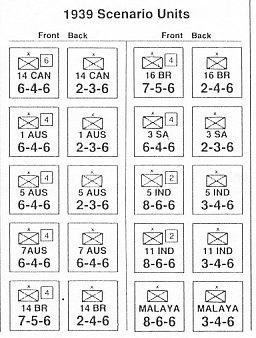From S&T#98
The 1939 Scenario
WHILE DISCUSSING THE WWII MALAYA campaign with me, David Isby posed the
question of what would have happened had the war in the Pacific broken
out simultaneously with the war in Europe - that is, between September
and December 1939. This scenario explores such a possibility. In
military terms, Japan lacked jungle training and several more years of
experience in China. In naval terms, the Japanese were not at their peak
yet, with the big carriers Shokaku and Zuikaku still under construction.
In aerial terms, the Zero fighter was not in production yet. On the
British side, the troop strength in Malaya was low, with the prospect
for reinforcements very different from that in 1941. The air complement
was not so obsolete as it would be later. In the naval sphere, however,
the Royal Navy had a few aces to play. While the East Indies Station at
Singapore had the 4th Cruiser Squadron and several destroyers available,
the more powerful China Station at Hong Kong had the 5th Cruiser
Squadron, the 21st Destroyer Flotilla, the aircraft carrier Eagle, and
the 4th Submarine Flotilla. This last formation, with 15 large fleet
submarines, was intended to employ wolfpack-style tactics to intercept
Japanese transports leaving the home islands. The lamentable state of
Japanese anti-sub warfare (ASW) capabilities and escort practices at
this time would have made an interesting situation. Finally, French
Indochina was not available as a Japanese base then.
Unit Counters.
Japanese units and arrivals are as normal. No Japanese air points are
available on turn 1. The Japanese player can receive 1 air point for
each air base he captures, up to a limit of 8 air points. The British
player uses three units from the original counter mix: the Indian 12th
Brigade, which sets up anywhere in Malaya; the SSVF unit, which sets up
in hex 1825, precluding an assault on Singapore on turn 1; and the FMSVF
unit, which sets up in hex 0109. The remainder of the Commonwealth
counters from the game are not used. The remainder of the counters used
in this scenario are printed as optional counters with this article. The
British Malaya Brigade is set up anywhere in Malaya. The British begin
the game with 4 air units deployed in any airfields in Malaya. An
additional air unit (Eagle's air wing) arrives at Singapore on turn 2.
While all Commonwealth counters have a "boxed," optional turn entry
number, as the scenario is optional, they all enter automatically on
their given turn. British reinforcements; (printed counters with this
article) all arrive automatically at Singapore and then move normally on
the inset map. If the British player wants to move these units onto the
large map in their turn of arrival, their movement restrictions are
noted below.
Turn 2.. Indian 5th and 11th Brigades (no movement onto large map this
turn).
Turn 3: Australian 1st, 5th, and 7th Brigades; British 14th and 16th
Brigades (all can move 3 movement points on large map this turn); and
3rd South African Brigade (no large map movement this turn.).
Turn 6: Canadian 14th Brigade (4 movement points on large map this
turn).
Game Rules.
Optional air point and stacking rules in this article are used.
[5.53] All Japanese reinforcements arrive by sea.
[8.0] Japanese zones of control are the same as Commonwealth zones.
Additionally, all Japanese infantry units have 6 movement points rather
than 8 movement points.
[6.4] The British Royal Navy Force Z is no longer applicable. Substitute
the following rule instead: China Station Submarine Interception. The
Commonwealth player can roll one die for each Japanese unit landing as a
reinforcement from off map or attempting East Coast movement: 1 = unit
is destroyed; 2 = unit loses 1 step and returns off map or to port of
origin (it can attempt a move next turn); 3 = unit aborts movement as
above, but does not lose a step; 4-6 = no effect.
[13.0] The Japanese can use all optional rules normally available. The
Commonwealth player, however, cannot use optional rules 13.2, 13.3,
13.5, or 13.8.

NB submitted by John Kula ([email protected])
on behalf of the Strategy Gaming Society
(http://www.boardgamegeek.com/~sgs),
originally collected by Andrew Webber
([email protected])
